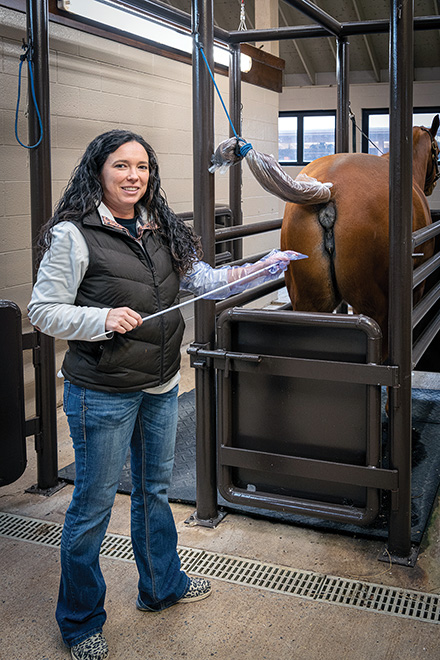While seasoned broodmare owners and their veterinarians understand how important it is to perform a uterine culture prior to breeding, there are still a lot of misconceptions around its importance, or when and if one is even necessary. However, a uterine culture provides invaluable information about a mare’s reproductive health.
Uterine cultures can help determine if a mare is free of infection, identify any potential pathogens, and determine the appropriate antibiotic to use to eliminate infection. When looking at the expense of shipping semen, stud fees, and the overall investment involved with breeding, taking every precaution when it comes to the mare’s health is imperative.
The Benefits
Many stallion contracts require a culture with or without a cytology prior to breeding season. However, if the mare has a poor reproductive history, problems foaling, or any evidence of abnormalities on the pre-breeding examination, a uterine culture and cytology are still strongly recommended by veterinarians for these reasons.
“A routine culture provides evidence that bacteria is present, and the sensitivity gives us options for treatment,” said Dr. Rilla Reese-Hanks, resident veterinarian at Masterson Farms LLC in Somerville, Tennessee. “A cytology can help us determine if inflammatory cells are present in addition to bacteria, fungus, yeast, mucus, and debris. A mare can have inflammation (endometritis) with or without infection, and it is important to identify the cause to maximize the mare’s ability to conceive.”
Mike Hay, owner of Pilot Knob Stud in Reddick, Florida, insists that any mare’s reproductive health starts with a uterine culture.
“You must start with a simple culture to rule out any uterine infections that would prevent pregnancy. Many of the common infections are not noticeable with daily handling. With the expense of shipping semen, culturing your mare may be the most cost-effective procedure you can do. Before you question your vet, your stallion’s semen, or your mare’s breeding ability, do a uterine culture.”
Nancy Kunkel, of Bedford, Kentucky, warns against being fooled by your own mares. She and her late husband, Paul, have been honored by the American Quarter Horse Association (AQHA) as 50-year Cumulative and Legacy Breeders.
“Even if a mare looks clean, like she doesn’t have an infection, you can’t always tell by checking her vulva that there is an infection present,” she said. “Doing cultures is a great baseline for you to see where your mare’s uterine health is at. It could be a mare who always cultures clean, and then one season not come up clean. It’s a gamble to not culture – especially when breeding a maiden mare because you just don’t know what you’re going to get.”
Becca Jacobsen, mare owner and breeder of Hillside Quarter Horses LLC, Burlington, Iowa, agrees.
“It’s better to be safe than sorry and always culture them first,” she said.
As the owner of Riverside Ranch in Sultan, Washington, Cindy Stephens-McCraw, along with her husband, Donnie, stands five AQHA stallions and, in addition to her role as a stallion manager, breeds many of her own mares. She always starts the breeding process with a culture.
“I feel that it is very important to have a uterine culture done on your mare before you even begin the breeding process,” she explained. “A bacterial growth is usually evident within 24 to 48 hours. It is not a very expensive procedure to have done, and you learn so much about what is going on inside of your mare that may block her from conceiving. Even if you decide to quit trying and wait until the following year to breed your mare, you should culture her and clean her out because if you leave an infection brewing, in most cases, that mare will not clean herself out. This can cause scar tissue or other problems within the reproductive tract that may cause her to become permanently barren.”
The Timing
Culturing will be most effective when performed close to breeding and conception. “By culturing close to conception, you have a more accurate understanding of the condition of her uterus. This allows you to address any concerns that may affect her fertility and conception,” Dr. Reese-Hanks says.
“Per my veterinarian’s recommendation, we always pull a culture before breeding season starts. Sometimes we even culture in January during their first heat cycle. If we see any retained fluid after delivery of a foal, we will treat with oxytocin, flush her, and then revisit with a culture if something seems out of the ordinary,” Jacobsen says.
The Reasons
It may also be necessary to culture a mare more than once during a breeding season to accurately monitor her uterine health.
“Re-culturing several times through the season may be needed for a pregnancy,” Hay said. “We would prefer to have a negative culture done within 30 days of breeding, or preferably within the same cycle. We would then repeat a culture after two attempts to breed if there are no other obvious reasons for why she didn’t take. If you’re dealing with an older mare, or a mare that has torn foaling, you may need to caslick (also known as vulvoplasty) or staple between procedures to help rule out contamination.”
Timing out a specific point in the mare’s heat cycle is also important when planning to perform uterine cultures.
“I like to see the mare cultured on day three to four of her heat cycle,” McCraw explains. “If you perform the culture too soon in the cycle, the cervix may be very tight and damage can be done if forced. When the cervix is relaxed, that is when you will have the best results.”
Hay also cautioned against assuming everything is fine with just one culture.
“We as breeders need to remember that regardless of washing techniques, breeding a mare is not a sterile procedure and re-culturing several times through the season may be needed for a pregnancy,” he said.
Fear of missing out on a breeding cycle is one of the most common reasons some may consider skipping the important step of performing a uterine culture before attempting to breed their mare.
“One reason I hear from mare owners that do not culture their mares is that they would lose the cycle, or it would take too long to get results back – time is money, after all,” Hay said. “Having a reproduction clinic that can set up the culture and identify results as soon as possible is a big asset for mare owners. But considering the expense of shipping semen and the overall investment involved, I believe it’s a necessary step.”
Another misconception is that a mare cannot be cultured, treated for any infection found, and then bred in the same cycle.
“There are many circumstances where a mare can be treated and bred on the same cycle,” Hay explained. “Although anytime there is more than one bacteria present, we routinely treat for three days in a row and then re-culture during the next cycle. Ideally, we would culture mid-cycle with the mare showing good edema. This also minimizes risk to her cervix if she is not in a good cycle.”
Some believe is that if there is an infection found and treated, then no follow-up culture is needed to verify the antibiotics cleared the infection before breeding. That’s not always the case.
“Some people may choose to re-culture their mare for a second time after the treatment to make sure the infection they were working on is in fact gone before they begin to breed,” McCraw said. “If the mare does not conceive within two cycles, it may be time to re-culture again and also do a uterine biopsy at that time. The biopsy can let you know the quality of the uterine lining and gives you an answer with percentage rates on if the mare can conceive. There comes a time when a biopsy is a must as it can also let you know if you have an untreatable condition.”
Kunkle said cultures are a useful tool at all stages of the breeding season.
“Having a clean culture at the start of breeding season doesn’t necessarily mean a culture isn’t needed later,” Kunkel said. “Even if a culture comes back clean and we breed them, I will culture them again. Sometimes infections can be resistant, and you just never know when an infection will appear or re-appear – especially during breeding season.”
Jacobsen agrees.
“This is especially true if you have a ‘problem’ mare,” she explained. “When it comes to infections, it’s better to be safe than sorry and make sure there is no chance of infection recurring again.”
Seasoned Breeders Know Uterine Cultures Are Not a Step to Skip
Bacterial infections are not uncommon among broodmares and sometimes this one skipped step could be what is standing between a mare and conception. McCraw says that the most common bacteria found in a culture that requires treatment are Escherichia coli (E. coli) and Streptococcus.
“I don’t believe in overtreating a uterus, however, as overusing antibiotics can lead to resistance to treatment as well as yeast overgrowth. Gentamicin and amikacin are a few common of the antibiotics used,” she explained. “I also like to lavage with saline for several days to help evacuate the infection. As a long-time breeder that has learned new tricks from old dogs, I have many recipes up my sleeve that I will pull out for the tough infections. In my career over the last 35 years, I have just loved it when someone would bring me a mare that nobody else could get pregnant so I could work my magic.”
Uterine Cultures may seem like an unnecessary, additional up-front expense to new breeders, but seasoned breeders know it will more than save money in the long run.
“In today’s modern breeding world, most all breeding’s are done via shipped cooled or frozen semen. If you are going to roll the dice and order semen without knowing your mare is reproductively sound, you could be looking at the cost on average of about $300 to $600 on receiving the semen and then around the same on the mare end per cycle,” McCraw said. “That is a pretty large gamble to do two or three times before culturing to make sure your mare is good to go, and you could then be more likely to have a one-shot deal. So, one little culture could save you thousands of dollars – not to mention the stress, disappointment, and extra time spent.”
Kunkel stresses that the cost of culturing is minimal compared to the overall costs to ship semen and breed your mare.
“I will even culture my mares who have had a caslick, just to be safe,” she said.
Dr. Reese-Hanks points out that costs vary depending on the area you are in and if you’re doing frozen or cooled semen, but in general, culturing prior to breeding season could certainly save you a lot of money if there is an infection present.
“If an infection is present, it allows you to treat it before having the cost of the collection, shipping and insemination fees,” she said. “In addition to the financial savings, you are more likely to have conception on the first heat cycle, and will therefore have a foal earlier in the year.”
Hay says that a uterine culture should be the first step even with maiden mares.
“In my experience, the small cost initially is over shadowed by the one in five chance that a young mare may have a contamination or immune system issue.”
Kunkel agrees.
“I learned the hard way in my first few years of breeding the importance of culturing,” she said. “I had a mare who got pregnant but lost the foal early in the pregnancy. We cultured her shortly after and found she had E-coli. My vet and I are certain the inhospitable environment of that infection was what caused her to lose the foal. It wasn’t even a raging infection – just a minor one. But it was enough that the pregnancy didn’t stick. So now, I culture all my mares before breeding. It’s less expensive to culture and be sure she’s clean than spend the money to breed her before knowing if there is an infection present.”
And don’t underestimate the value of an experienced reproduction veterinarian.
“Getting a great repro vet who you can trust is the best thing you can do as a mare owner and breeder,” she said.
Overall, it is in you and your mare’s best interest to spend the up-front cost to perform a uterine culture when planning out your next breeding season.








You must be logged in to post a comment Login